
* Initial attempts to build helicopters began optimistically but quickly ran into serious obstacles. A group of European helicopter pioneers spent decades working toward the goal of a practical rotorcraft, and by the beginning of World War II had managed to get workable helicopters into the air.
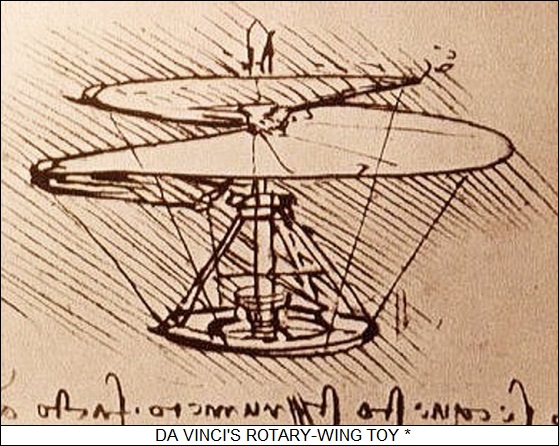
* The basic idea of a helicopter -- flight through rotating horizontal wings or "rotors" -- goes back at least 1,500 years, through a simple invention known as the "Chinese top" that still survives today in various forms. This is a toy with a rotor blade mounted on a stick, and spinning the stick between the palms of the hands or by pulling a string wound around it causes it to soar into the air. The toy eventually made its way from China to Europe, where it appeared in paintings dating as far back as 1463. Not long after that, in 1483, Leonardo da Vinci illustrated a more sophisticated "rotary-wing" toy in his famous notebooks. However, building a rotary-wing aircraft that was any more than a toy was beyond the technology of the time, and remained so for centuries.
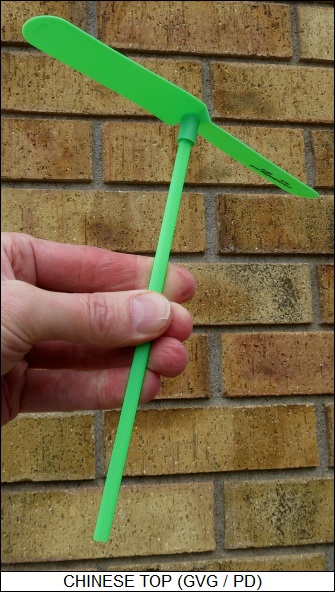
In 1784, two Frenchmen, the naturalist Launoy and the artisan Bienvenu, demonstrated a rotary-wing toy that improved on the Chinese top. Their device consisted of a shaft with rotors on each end, with a string under tension that could be wound around the shaft. Once wound up, the toy then flew into the sky. Although this device was still a toy, Launoy and Bienvenu had moved a significant step beyond the Chinese top, since their device was self-powered. It also addressed one of the major design considerations of a self-powered rotary-wing vehicle: torque. When a rotary-wing aircraft spins its rotor in one direction, the machine itself tends to spin in the other. The rotors of Launoy and Bienvenu's toy spun in opposite directions, or "contra-rotated", canceling out torque. The two rotors were mounted on the same shaft, a configuration now known as "coaxial".
A young Englishman named Sir George Cayley published a design for a similar toy in 1809 that could be put together from cheap and common materials, using feathers for rotor blades, for example. In the 1840s, Cayley began to consider designs of larger rotary-wing aircraft, drawing a machine with two contra-rotating rotors, each on one side of the aircraft. However, Cayley never tried to actually build his machine, since he lacked a practical powerplant.
In the 1860s, a Frenchman named Viscount Gustave de Ponton d'Amecourt experimented with small flying coaxial rotary-wing aircraft models. D'Amecourt's ingenious and competent models used springs for power, and he even designed one that ran on steam power -- though that one didn't get off the ground. He named his machines "helicopteres", after the Greek phrase for "spiraling wing". In the 1870s, another Frenchman, Alphonse Penaud, devised helicopters and fixed-wing aircraft toys powered by wound-up rubber bands, a scheme that is still used for flying toys. Some of Penaud's models flew elegantly, but he was unable to find a power source adequate for larger flying machines. Penaud, frustrated and ridiculed, suffered more than he could bear, and shot himself at age 30.
BACK_TO_TOP* The lack of an engine with a sufficiently high power-to-weight ratio held back development of a passenger-carrying helicopter, and indeed of all large heavier-than-air flying machines. The American inventor Thomas Alva Edison tried to develop a helicopter based on a guncotton-powered engine in the early 1880s -- but after an explosion that singed him and badly burned one of his staff, he gave it up, though he expressed confidence that the concept would ultimately be made to work.
In 1886, the French writer Jules Verne published a novel titled ROBUR THE CONQUERER or THE CLIPPER OF THE CLOUDS, in which the title character possessed a great flying ship, named the ALBATROSS, that flew through the air on a forest of rotors. Robur used the ALBATROSS to cruise around the world and carry out attacks on different nations. The ALBATROSS was nothing that resembled a practical flying machine, but the book helped popularize the idea of crewed rotary-wing flight.
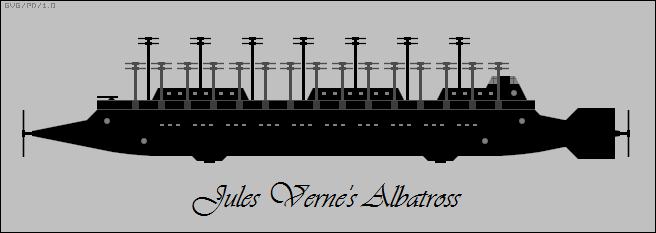
The introduction of a practical internal combustion engine by Niklaus Otto of Germany in 1876 opened the door to heavier-than-air flight. The first flight of a man-carrying heavier-than-air aircraft took place in December 1903, when the Wright brothers flew their "Wright Flyer" at Kittyhawk, North Carolina. In the next few years, flight pioneers worked on both fixed-wing and rotary-wing aircraft. At the time, fixed-wing aircraft were still very primitive, and some workers in the new field of aviation believed that rotary-wing aircraft were the better bet over the long run.
On 29 September 1907, French aviation pioneer Louis Charles Breguet managed to lift off the ground in a helicopter of his own design, the "Gyroplane #1", a great spindly framework in the shape of an "X" with biplane rotors on the corners. It has been described as something like "four fallen windmills lashed together". The flight lasted about a minute and went no higher than a meter, since the machine was held down to the ground by four men. Breguet had not solved the problem of controlling the direction of flight of his helicopter, a problem that would plague helicopter designers for decades.
The first untethered flight of a helicopter took place a short time later, on 13 November 1907, when another Frenchman, Paul Cornu, flew for a few minutes about a meter off the ground in a helicopter with fore-and-aft contra-rotating rotors. Cornu didn't manage to solve the control problem either, and that was about as far as he got. Some modern observers have looked over his helicopter design and question that he even got that far, asserting that it was impossible for the thing to have got off the ground at all. In 1908, fixed-wing aircraft set a number of records for performance and endurance, and were continuing to improve at a rapid pace; the helicopter was clearly not the best bet over the short run. Breguet moved on to fixed-wing aircraft for the time being.
* Other inventors kept tinkering with helicopters. Many designed craft that were as laughable as they were unflyable -- but a few managed to get off the ground, though their pilots were generally glad to get back down on it again before very long.
In 1909 and 1910 Igor Ivanovich Sikorsky, born in Kiev of Russian-Polish parents in 1889, designed a pair of helicopters. He had been inspired by Jules Verne's stories and da Vinci's sketches. Sikorsky's machines didn't fly, but Sikorsky filed the ideas away for later. A Russian named Boris Yuriev also tried to fly a helicopter in 1912. Yuriev's helicopter was unsuccessful, but it was one of the first to feature a large main rotor and a small side-mounted tail rotor to cancel torque, a configuration that would eventually dominate helicopter design.
Jacob C.H. Ellehammer of Denmark hopped into the sky on his machine in 1912. In the United States, a German immigrant named Emile Berliner and his son Henry built a series of helicopters beginning in 1908, but none of them flew very well. Another immigrant to the US, a Russian named George de Bothezat, built a helicopter named "the flying octopus" in the early 1920s with US Army funds, but the Army finally decided to scrap the project. Later in the decade, yet another American helicopter researcher named Maitland Bleecker got the Curtiss company to fund work on a helicopter with a rotor spun by propellers at the rotor tips! The propellers were driven by shafts running down the rotor blades from a single piston engine.
Marquis Raul Pateras Pescara, an Argentine working in Spain and France, built several coaxial helicopters in the early 1920s that actually stayed in the air for an extended period of time and could be flown around in a controlled, if very labored, fashion. Pescara's helicopters were arguably the most advanced designs of the 1920s, and he solved several critical problems in helicopter design:
A Frenchman named Etienne Oehmichen designed an elaborate helicopter with six rotors and eight propellers that won a prize in 1924 for a flight over a one-kilometer course. A Russian-born inventor living in Belgium named Nicholas Florine developed a fore-and-aft contra-rotating helicopter in the early 1930s that stayed in the air for ten minutes. This is by no means a full list of all the helicopters developed up to the 1930s; it matters little, to the extent any were successful, it was only in very limited ways. All these machines were ugly mechanical monstrosities that gave no reason to believe that the age of the helicopter was right around the corner.
BACK_TO_TOP* The first practical rotary-wing aircraft was built by a Spaniard named Juan de la Cierva after the First World War. His "autogiro" (his trademarked spelling) AKA "autogyro" (the spelling used by others), later "gyrocopter" or "gyroplane", was not a helicopter, instead being a somewhat odd but perfectly workable cross between a fixed-wing aircraft and a helicopter.
La Cierva's autogiro was essentially the fuselage of a fixed-wing aircraft with a rotor mounted on top. The rotor was unpowered, being spun up from the draft of the propeller in the front of the aircraft and from the wind caused by the forward motion of the aircraft. The spinning rotor allowed the autogiro to take off in a short distance; or land straight down using autorotation. An autogiro could even hover if faced into a stiff breeze. There was no need to counter torque, since the rotor was not power-driven.
One of the obstacles that la Cierva had to deal with was a fundamental helicopter design issue known as "asymmetry of lift". If a helicopter is moving forward, the rotor blade that's moving forward generates more lift than the rotor blade that's moving backward. Early helicopters, which had fixed rotor blades, tended to tip over because of this problem. La Cierva's solution was to hinge the rotor blades to the hub, allowing them a degree of travel up-and-down and back-and-forth. Although such a simple scheme sounds dodgy, in fact the movement of the blades compensated very well, rising as they moved forward and falling as they moved back. A rotor blade at an upward angle tended to lose lift, balancing the autogiro.
* La Cierva began work on autogiros in 1920, but didn't actually make one that could get off the ground safely until he discovered the principle of hinged blade system. He stumbled onto the idea by accident while tinkering with a rubber-band-powered model. His "C-4" autogiro, which incorporated the hinged-rotor scheme, first flew on 9 January 1923. The C-4 was modified from a wartime French Hanriot fighter and still had wings for flight control. Later la Cierva autogiros did not have wings, achieving the appropriate steering through cyclic pitch control. Late-model la Cierva autogiros also had a clutch to allow the aircraft's engine to "spin up" the rotor blades before take-off, though the rotor spun freely once in flight.
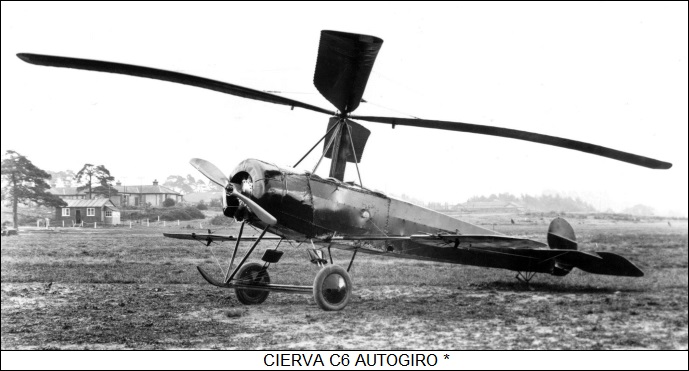
It is unclear if la Cierva got the idea of cyclic pitch control from Pescara. It is plausible that both inventors discovered it independently, but it is clear that la Cierva was the first to implement cyclic pitch control in a production machine. La Cierva established a factory to build autogiros in Britain, with the "flying windmill" becoming something of a sensation. They were manufactured in many countries, with the Japanese producing a total of 240.
La Cierva licensed the enthusiastic Harold Pitcairn to build them in the United States. The DETROIT NEWS used one to send reporters to the scene of accidents or other newsworthy events, and the US Postal Service experimented with them for mail delivery. Pitcairn believed that they could be sold as a "flying car" for wealthy customers, and designed a prototype two-seater that had folding rotors and could be driven on city streets. The Kellett company of the US also built gyroplanes, with one taken by Admiral Byrd on an Antarctic expedition in 1933, and delivered a few for US Army Air Forces (USAAF) evaluation as the "XR-2" and "XR-3".
There wasn't that much enthusiasm for gyroplanes, however. Military forces didn't have a serious need for them, and as the Great Depression was in progress, there was no market for them as a rich person's toy, no matter how sexy they were.
La Cierva was killed in an airliner crash near London in December 1936. By that time, workable helicopters were beginning to appear, and the gyroplane went into eclipse. They survived through the rest of the century mostly as an ultralight aircraft for enthusiasts such as the Bensen gyrocopters and unpowered gyrogliders, with thousands sold, mostly in kit form, to the present day. The relative obscurity of the gyroplane following the death of la Cierva does not diminish the importance of his work: he had developed the very first practical, production rotorcraft.
BACK_TO_TOP* By the mid-1930s, helicopter technology was reaching a critical mass. In 1930, inspired by la Cierva's efforts, Louis Breguet returned to experiments with helicopters. Since he was busy manufacturing fixed-wing aircraft, he set up a separate business organization and delegated the detail work to a young engineer named Rene Dorand.
The result was a coaxial helicopter of almost modern appearance that was light-years beyond Breguet's Gyroplane #1 of 1907. However, by this time, Breguet was older and wiser, and the new aircraft was purely experimental, as reflected by its name, the "Gyroplane-Laboratoire". He also did not invest major funds in its development, using parts salvaged from other aircraft to build the machine. Attempts to fly the Gyroplane-Laboratoire began in 1933, initially with no success. However, Breguet and Dorand kept at it, continuing to refine their design, and in November 1937 it won a French Air Ministry prize for a helicopter that could fly an extended circuit and perform other specified flight tests.
Although some partisans of Breguet and Dorand claim, with some justification, that the Gyroplane-Laboratoire was the first workable helicopter, it was difficult to control and "shook like a bag of walnuts". It might well have been made to work; Breguet and Dorand continued to tinker with the machine but their progress was slow, and it was finally badly damaged in a hard landing in June 1939. With war looming, Breguet abandoned his work on helicopters. The Gyroplane-Laboratoire was destroyed in an air raid in 1943.
* The Gyroplane-Laboratoire was a huge step forward, but the generally recognized inventor of the first practical helicopter was Professor Heinrich Focke of Germany, who had helped found the Focke-Wulf aircraft firm. Focke did not like the Nazis, and after they came to power, they forced him out of the company in 1933. Focke turned to building and refining gyroplanes, then moving on to work on his "Model 61" helicopter -- or "hubschrauber" as the Germans call them. Two were built, the first flying in the spring of 1936. It was the first practical, fully-controllable helicopter to take to the air. It wasn't easy to fly, but it could reliably do all the essential maneuvers of a modern helicopter.
The Model 61 clearly demonstrated roots in gyroplane design. It was built around the fuselage of a Focke-Wulf Fw 44 Steiglitz biplane, and looked like a gyroplane with a rotor on an outrigger to each side of the fuselage. It retained an engine and propeller in the nose, but the 120 kW (160 HP) radial engine actually drove the two rotors in a contra-rotating fashion. The Focke Model 61's propeller was not used for flight power. There's an old joke among private airplane pilots that a propeller isn't used to power an airplane -- it's just used to keep the pilot cool, and this can be proven because a pilot starts sweating in a big way when the propeller stops turning. In the case of the Model 61, that was almost true, since the only function of the little propeller was to keep the radial engine cool.
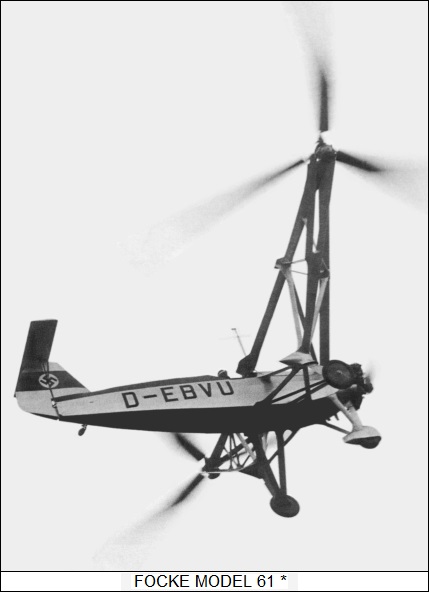
The Model 61 attracted little public attention at first, since it seemed to be little more than a freakish variation on the gyroplane. Then, in February 1938, it attracted widespread notice when it was flown in the enclosed Detschlandhalle sports arena in Berlin at a huge Nazi gathering, with 25-year-old Hanna Reitsch at the controls. Reitsch was a German superstar, an expert test pilot with first-class flying skills and very cool nerves, a personal friend of Adolf Hitler himself. Her petite size came in useful in flying experimental aircraft, which were often small and underpowered. She flew the Model 61 inside the arena every night for three weeks, making the helicopter front-page news all over the world. In her hands, it seemed to effortlessly float in any direction with complete command of the air -- though given Reitsch's flying skills, she probably could have performed aerobatics with a concrete block if it had been fitted with wings and an engine.
* The Focke-Achgelis company, organized under Nazi consent with aviator Gerd Achgelis as a partner to produce Focke's helicopters, went on to build an enlarged, six-passenger version of the Model 61, designated the "Fa 266 Hornisse (Hornet)", for the Deutsche Lufthansa airline. It performed its first flight in August 1940, but by that time development funding had been taken over by the military, which redesignated the helicopter the "Fa 223 Drache (Dragon)".
The Fa 223 was a practical operational helicopter, and indeed as or more capable than any other helicopter produced during the war. It was powered by a 745 kW (1,000 HP) piston engine, could carry a pilot and an observer, and could be fitted with an electric rescue hoist and a machine gun in the nose. It could haul a load of up to 1,280 kilograms (2,820 pounds) slung underneath the helicopter or inside its spacious cabin, and could be armed with bombs or mines.
___________________________________________________________________
FOCKE-ACHGELIS FA 223:
___________________________________________________________________
rotor diameter:
12 meters (39 feet 4 inches)
span over rotors:
24.5 meters (80 feet 5 inches)
fuselage length:
12.25 meters (40 feet 2 inches)
height:
4.35 meters (14 feet 3 inches)
empty weight:
3,175 kilograms (7,000 pounds)
max loaded weight:
4,310 kilograms (9,500 pounds)
maximum speed:
175 KPH (109 MPH / 95 KT)
service ceiling:
2,000 meters (6,600 feet)
range:
700 kilometers (435 MI / 378 NMI)
___________________________________________________________________
Hundreds of Fa 223s were ordered, but low production priority and Allied bombing ensured that only a few were completed. The Czechs assembled two from German components after the war, and the French produced their own version, the "Sud-Est SE-3000", in 1948.
* The one rotorcraft to be actually built in quantity by the Germans during the war was the "Fa 330 Bachstelze (Wagtail)". It looked a little like an ultralight helicopter, with a metal-tube frame, a standard aircraft tail assembly, and the pilot sitting exposed on a frame seat under a rotor.
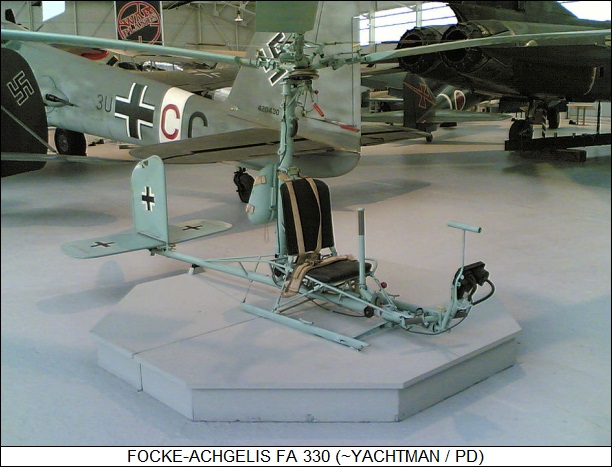
It had a three-bladed rotor with a diameter of 8.5 meters / 28 feet (7.3 meters / 24 feet in early production), and a total weight of about 72 kilograms (160 pounds). About 200 were built, with the type beginning service in mid-1942. At least two were provided to the Japanese.
Actually, the Fa 330 was a gyroglider or "rotor kite". It was pulled behind a German U-boat (submarine) during surface cruise to provide a long-range observation platform for spotting targets or threats. It could be broken down and stowed in a few minutes, and then pulled out of storage and reassembled for use just as quickly. The Fa 330 proved impractical for U-boat patrols in the North Atlantic, since wide-ranging Allied air patrols made a U-boat commander reluctant to do anything that prevented him from diving quickly, but it was used to some extent in the Indian Ocean.
The Focke-Achgelis company also designed an ultralight one-man helicopter designated the "Fa 336" along the lines of the Fa 330, and also primarily intended as an observation platform for submarines. It could be broken down and stowed. The Fa 336 never went into production, though apparently Sud-Est built an ultralight helicopter based on it after the war.
In fact, Professor Focke and his team worked on a number of interesting rotary-wing projects that didn't get beyond the paper design stage. The "Fa 284" was an enlarged Fa 223 with twin piston engines, and was intended to be a "flying crane" to lift heavy slung loads, or a big belly cargo pod with clamshell doors in the front.
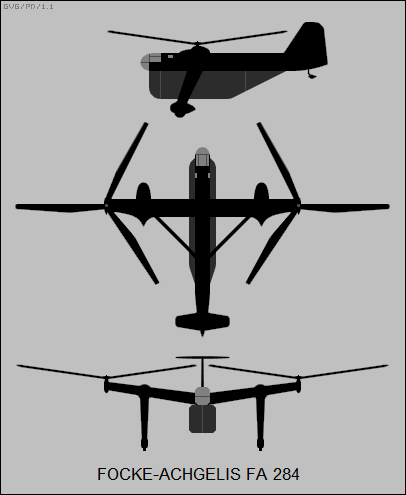
The Fa 284 was abandoned in favor of a flying crane consisting of two Fa 224s connected end to end, but that aircraft wasn't completed, either. Even more imaginative concepts included a "tilt-rotor" aircraft designated the "Fa 269", which resembled a conventional aircraft with twin props that could tilt downward to provide short take-off and landing capabilities, and the "Fa 283", which was a turbojet-powered gyroplane transport. Both appear to have been little more than pipe dreams -- though in the postwar period, the Dornier firm would build an experimental aircraft, the "Do 29", along the lines of the Fa 269 that would demonstrate the validity of the concept.
* Another German, an experienced aviation engineer named Anton Flettner, had been working on helicopters in parallel with Focke. His first helicopter, built in 1930, was a bizarre and unworkable machine with twin engines and propellers attached to the main rotor. It was wrecked in testing, but Flettner simply decided to back up and try again. He designed a gyroplane, the Flettner "Fl 184", to get his concepts on track. After initial test flights, Flettner then powered the rotor of the machine and removed the propeller from the nose, replacing it with two small propellers, each on an outrigger, to provide control and forward thrust. It was inelegant, but it worked.
In 1937, Flettner began work on a much more refined helicopter, the "Fl 265". This aircraft had a single engine driving two contra-rotating rotors through a gearbox. The twin-bladed rotors were on shafts on either side of the gearbox, with the gear arrangement keeping the two rotors at a right angle to each other, and the shafts turned outward slightly so the rotors intermeshed without colliding. This is known as an "eggbeater" configuration, and is still used in some modern helicopters.
The German Navy began to provide funding to Flettner in 1938, and the Fl 265 made its first flight in May 1939. The Fl 265 led to a bigger and refined production version, the "Fl 282 Kolibri (Hummingbird)", with a 120 kW (160 HP) radial engine. The Kolibri was much smaller than the Fa 223 Drache, but could carry a crew of three, and was extremely agile. The German Navy conducted exercises in early 1941 in which a Kolibri dodged attacks by two fighter planes for 20 minutes.
The Kolibri promised to be an excellent naval scout and observation machine, and a thousand were ordered -- but as with the Fa 223, only a small number were completed.
___________________________________________________________________
FLETTNER FL 282 KOLIBRI (V21 PROTOTYPE):
___________________________________________________________________
rotor diameter:
11.96 meters (39 feet 3 inches)
fuselage length:
6.56 meters (21 feet 6 inches)
height:
2.20 meters (7 feet 2 inches)
empty weight:
760 kilograms (1,676 pounds)
max loaded weight:
1,000 kilograms (2,200 pounds)
maximum speed:
150 KPH (93 MPH / 81 KT)
service ceiling:
3,300 meters (10,800 feet)
range:
170 kilometers (106 MI / 92 NMI)
___________________________________________________________________
* In addition to the Focke-Achgelis and Flettner helicopters, a few experimental ultralight helicopters were developed by the Austrian Nagler-Rolz company, and by an Austrian engineer named Paul Baumgartl. Another Austrian, named Friedrich von Doblhoff, also developed the first flyable "tipjet" helicopter, the "WNF 342". In this scheme, the rotor has some type of jet unit at the tips to cause rotation. Since the rotor turns itself, this eliminates the need to cancel torque. Von Doblhoff's designs used a piston engine to compress air, which was pumped to the rotor tips through pipes, and then mixed with fuel in a small combustion chamber in the rotor tips to create a fast gas jet. The rotor was only driven for take-off and landings; the machine had a pusher propeller and flew like a gyroplane in normal flight.
Von Doblhoff built four prototypes between 1942 and 1945, the last of them having a weight of 640 kilograms (1,410 pounds), a rotor diameter of 9.9 meters (32 feet 6 inches), and an Argus As-411 piston engine providing 100 kW (135 HP). His machines never went into production, and in fact no tipjet helicopter ever has. Although the tipjet concept has been revisited many times in different forms, it has never been used in any full-production helicopter design.
While the Germans were pioneers in helicopter development and operations, the country's defeat in World War II meant that leadership in the postwar development of the field would pass to other countries, in particular the United States.
BACK_TO_TOP